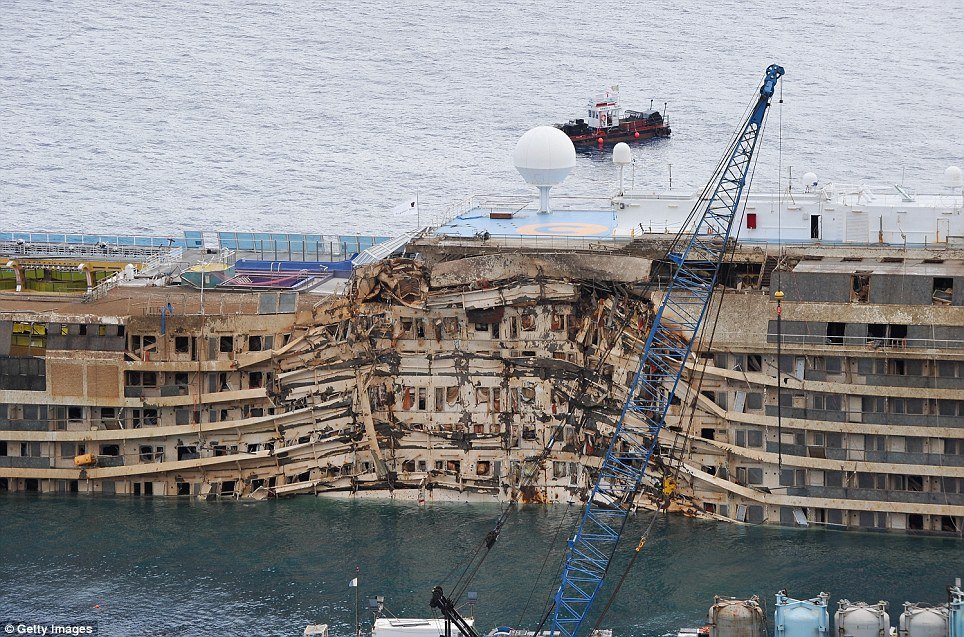Table Of Content

Thirty-two people died after the Costa Concordia cruis ship ran aground with more than 4,000 passengers and crew on 13 January 2012, only hours after leaving the Italian port of Civitavecchia. Costa Concordia disaster, the capsizing of an Italian cruise ship on January 13, 2012, after it struck rocks off the coast of Giglio Island in the Tyrrhenian Sea. Several of the ship’s crew, notably Capt. Francesco Schettino, were charged with various crimes. Lawyers for the state said every passenger and crew member on board could have survived if Schettino had immediately ordered an evacuation. Instead, over months of testimony, the court heard how the captain initially told passengers and officials on land that the ship, which went dark after the crash, had a power outage and was not in peril.
Costa Concordia Wreck Site Now
In July 2014 the Concordia—outfitted with a number of steel containers serving as flotation devices—was towed to Genoa, Italy, where it was dismantled for scrap. And three giant Costa cruise ships are anchored near La Spezia, "motors running, lights on, and with small crews aboard," Fortune reporter Eric J. Lyman wrote. It was Schettino’s decision to abandon his post before all the passengers were evacuated and seek safety on board a lifeboat that most enraged Italians after the disaster. While Schettino insisted in court that he had slipped and fallen into the safety of the lifeboat, that claim was thoroughly discredited by prosecutors.
Costa Concordia captain Francesco Schettino guilty of manslaughter
Accounts of a musician forfeiting his chance of escape for others and local fishermen navigating treacherous waters to rescue passengers have been etched into the annals of heroic acts the world should never forget. The ship's captain Francesco Schettino is on trial for manslaughter, causing a shipwreck and abandoning the ship before all the passengers had been evacuated - even though he has claimed that he fell into a lifeboat. GIGLIO ISLAND, Italy (AFP) - Italy's Costa Concordia will set sail on its final voyage on Wednesday as survivors look on, two and a half years after the luxury cruise ship crashed and sank in a nighttime disaster that left 32 people dead. Whether or not Captain Francesco Schettino was trying to impress his girlfriend is debatable. The wreck was not the fault of unexpected weather or ship malfunction—it was a disaster caused entirely by a series of human errors.
Italy cruise ship Costa Concordia accident eyewitness accounts
The Costa Concordia began taking on water after it struck a reef, leading to a chaotic evacuation process to save the lives of passengers and crew members. Let’s delve into the specifics — the cruise industry witnessed the birth of new lifesaving protocols and evacuation drills that were now to be completed before a ship could even leave the harbor. Crew members underwent extensive training, focusing on their assigned roles and emergency response techniques. It was evident that the prior status quo could no longer stand, with the cruise ship crash Italy event catalyzing change.
The echoes of the catastrophe stretch into the present, as each anniversary passes with the gravity of loss undiminished. Mindful of the human cost, it’s not just about recounting the Costa Concordia deaths but also about preserving the memory of each person who perished in the dark waters of that fateful night. The severity of the ship’s tilt demanded adaptability and courage, cornerstones of the human spirit in the face of calamity. Approximately 300 souls remained onboard as the last crew detached, spurring a flurry of survival strategies, including climbing down ladders in a landscape where decks had transformed into walls. In my carnal pursuit of sharing this catastrophe’s account, I am reminded of how closely we skirt the edges between safety and danger and the immeasurable responsibility of those commanding such grand vessels.
Litman: How Trump’s trial will go well beyond the charges to paint a damning portrait of him
A decade after that harrowing night, the survivors are grateful to have made it out alive. The calamity caused changes in the cruise industry like carrying more lifejackets and holding emergency drills before leaving port. "I felt like (my daughters) were going to get trampled, and putting my arms around them and just holding them together and letting the sea of people go by us." Alaska resident Nate Lukes was with his wife, Cary, and their four daughters aboard the ship and remembers the chaos that ensued as the ship started to sink. The Dutch salvage firm Smit brought a barge alongside the ship and divers installed external tanks to collect the diesel.
What happened to the Costa Concordia? Cruise.Blog - Cruise Blog
What happened to the Costa Concordia? Cruise.Blog.
Posted: Thu, 11 May 2023 07:00:00 GMT [source]
The Italian cruise ship ran aground off the tiny Italian island of Giglio after striking an underground rock and capsizing. To understand the tangible changes post-Costa disaster, I delved into the modifications in training and regulations. The Carnival sinking cruise ship 2012 incident underscored the need for more intensive crew training, emergency preparedness, and passenger safety briefings.
Costa Cruises and its parent companies

On 16 September 2013, the parbuckle salvage of the ship began, and by the early hours of 17 September, the ship was set upright on her underwater cradle. In July 2014, the ship was refloated using sponsons (flotation tanks) welded to her sides, and was towed 320 kilometres (200 mi) to her home port of Genoa for scrapping, which was completed in July 2017. Almost immediately questions were raised concerning the conduct of Schettino and other crew officers. In July 2013 four crew members and Costa Crociere’s crisis coordinator pled guilty to various charges, including manslaughter.
As the maritime community continues to remember the lives lost during the 2012 carnival sinking cruise ship tragedy, the commitment to perpetuating these enhanced cruise safety practices remains unwavering. To this day, the impact of the Costa Concordia disaster reverberates through every drill performed, every check made, and every safety briefing held on cruise ships roaming the seas. Such a colossal event reshaped an industry, and as we move forward, it steadfastly informs a global mission to secure the safety and enjoyment of passengers and crew for generations to come. During his trial, which I followed closely, the Concordia shipwreck captain faced severe backlash for mishandling the situation, culminating in a conviction for manslaughter and causing a maritime disaster.
Then the ship rolled again, now listing to the right, and the captain ordered the ship to be abandoned. "The boat started shaking. The noise - there was panic, like in a film, dishes crashing to the floor, people running, people falling down the stairs," said survivor Fulvio Rocci. "We were having supper when the lights suddenly went out. We heard a boom and a groaning noise. All the cutlery fell on the floor," Luciano Castro told Italy's Ansa news agency.
He was also found guilty of causing the wreck and of deserting his post, but he escaped immediate arrest and will remain free pending his appeal. Mr Metcalf, from Dorset, told the BBC his daughter had phoned to say she was safe but that she had feared she would have to jump into the sea. She said blankets and clothes were provided for those who arrived on the island, while churches and schools were opened to ensure that people had a roof over their head. Cruise ship shop worker Fabio Costa said when people realised there was a serious problem, there were scenes of desperation.

These revisions were not mere suggestions but mandatory steps to solidify trust in cruise vacations for passengers and crew members alike. When the Costa Concordia succumbed to the sea, it represented a Concordia cruise disaster and raised immediate environmental concerns the Costa Concordia area had to contend with. The marine sanctuary, which could have suffered irreversible damage due to the cruise liner sinking in 2012, desperately needed protective measures. The salvage operations Concordia undertook were a race against time to minimize the ecological footprint of the wreckage. We solemnly remember the concordia deaths that irreversibly marked the Costa Concordia’s profound tragedy.
Dramatic openingSchettino himself has become a lightning rod for international disdain for having left the ship before everyone was evacuated. Monday’s hearing was the first and most important in a preliminary trial, aimed at establishing who should be indicted over the disaster. Ananias and her family declined Costa’s initial $14,500 compensation offered to each passenger and sued Costa, a unit of US-based Carnival Corp., to try to cover the cost of their medical bills and therapy for the post-traumatic stress they have suffered. There are going to be substantial risks before the Costa Concordia is gone for good, however. As CNN writes, the ship's rotting hull could break off as it is jostled about, which would cause lengthy delays.
He was accused of taking the liner too close to the shore and then abandoning ship with passengers and crew still on board. Ortelli was later on hand when, in September 2013, the 115,000-ton, 300-metre long cruise ship was righted vertical off its seabed graveyard in an extraordinary feat of engineering. "I imagine it like a nail stuck to the wall that marks that date, as a before and after," he said, recounting how he joined the rescue effort that night, helping pull ashore the dazed, injured and freezing passengers from lifeboats. The sad anniversary comes as the cruise industry, shut down in much of the world for months because of the coronavirus pandemic, is once again in the spotlight because of COVID-19 outbreaks that threaten passenger safety.
The work done by salvage teams was not just a technical achievement but a concerted effort to preserve a vulnerable ecosystem that had the misfortune of being the stage for this tragedy. As an observer and reporter, I’ve seen firsthand how a once vibrant vacation remnant is now a silent watchdog, ensuring the sanctuary’s safety. The sunken cruise ship, a convergence of human tragedy and ecological peril, has become an inadvertent monument to both. Monica, a German passenger who was in the cruise liner's theatre when the ship began to suffer problems, said it was hard to reach the lifeboats.

No comments:
Post a Comment